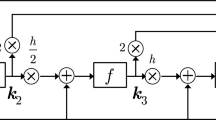Abstract
This article carries out a comparative study of zero-finding neural networks for nonlinear functions. By taking the view that artificial recurrent neural nets are dynamical systems described by ordinary differential equations (ODEs), new neural nets were recently derived in the literature using a unified control Liapunov function (CLF) approach, after interpreting the zero finding problem as a regulation problem for a closed-loop continuous-time dynamical system. The resulting neural net or continuous-time ODE is discretized by Euler’s method and the discretization step size interpreted as a control which is chosen so as to optimize the decrement in the chosen CLF, along system trajectories. Given the viewpoint adopted in this article, the words dynamical system, ODE and neural net are used interchangeably. For standard test functions of two variables, the basins of attraction are found by numerical simulation, starting from a uniformly distributed grid of initial points. For the chosen test functions, analysis of the basins shows a correlation between regularity of the basin boundaries and the predictability of convergence to a zero. In addition, this analysis suggests how to construct a team algorithm with favorable convergence properties.
Similar content being viewed by others
References
Attouch H., Cominetti R.: A dynamical approach to convex minimization coupling approximation with the steepest descent method. J. Differ. Equ. 128, 519–540 (1996)
Attouch H., Teboulle M.: Regularized Lotka–Volterra dynamical system as continuous proximal-like method in optimization. J. Optim. Theory Appl. 121(3), 541–570 (2004)
Baran B., Kaszkurewicz E., Bhaya A.: Parallel asynchronous team algorithms: convergence and performance analysis. IEEE Trans. Parallel Distrib. Syst. 7(7), 677–688 (1996)
Bhaya A., Kaszkurewicz E.: Iterative methods as dynamical systems with feedback control. In: Proceedings of the 42nd IEEE Conference on Decision and Control, Maui, Hawaii, pp. 2374–2380 (2003)
Bhaya A., Kaszkurewicz E.: Control Perspectives on Numerical Algorithms and Matrix Problems, Advances in Control. SIAM, Philadelphia (2006)
Bhaya A., Kaszkurewicz E.: A control-theoretic approach to the design of zero finding numerical methods. IEEE Trans. Autom. Control 52(6), 1014–1026 (2007)
Branin F.H.: Widely convergent method to finding multiple solutions of simultaneous nonlinear equations. IBM J. Res. Develop. 16(5), 504–522 (1972)
Chao K.S., de Figueiredo R.J.P.: Optimally controlled iterative schemes for obtaining the solution of a non-linear equation. Int. J. Control 18(2), 377–384 (1973)
Dixon L.C.W., Gomulka J., Szegö G.P.: Towards a global optimization technique. In: Dixon, L.C.W., Szegö, G.P. (eds) Towards a Global Optimization, pp. 29–54. North Holland, Amsterdam (1975)
Goh B.S.: Algorithms for unconstrained optimization via control theory. J. Optim. Theory Appl. 92(3), 581–604 (1997)
Gomulka J.: Remarks on Branin’s method for solving nonlinear equations. In: Dixon, L.C.W., Szegö, G.P. (eds) Towards a Global Optimization, pp. 96–106. North Holland, Amsterdam (1975)
Hardy J.W.: An implemented extension of Branin’s method. In: Dixon, L.C.W., Szegö, G.P. (eds) Towards a Global Optimization, pp. 117–142. North Holland, Amsterdam (2002)
Hauser R., Nedić J.: The continuous Newton–Raphson method can look ahead. SIAM J. Optim. 15(3), 915–925 (2005)
Hedge S., Kacera S.: Safeguarded Zero-Finding Methods. Computer Science Department Research Report. Courant Institute of Mathematical Sciences, New York University, New York (2006)
Laskari E.C., Parsopoulos K.E., Vrahatis M.N.: Evolutionary operators in global optimization with dynamic search trajectories. Numer. Algorithms 34, 393–403 (2003)
Leake D., Mukai H.: Acceleration of one-step stationary root-finding algorithms. J. Numer. Anal. 9, 81–93 (1989)
Riaza R., Zufiria P.J.: Weak singularities and the continuous Newton method. J. Math. Anal. Appl. 236(2–3), 438–462 (1999)
Treccani G.: On the convergence of Branin’s method: a counter-example. In: Dixon, L.C.W., Szegö, G.P. (eds) Towards a Global Optimization, pp. 107–116. North Holland, Amsterdam (1975)
Zufiria P.J., Guttalu R.S.: On the role of singularities in the Branin’s method from dynamic and continuation perspectives. Appl. Math. Comput. 130, 593–618 (2002)
Author information
Authors and Affiliations
Corresponding author
Additional information
This research was partially supported by grants from FAPERJ (CNE), CNPq (BPP, PNPD, Universal), CAPES (ProEx).
Rights and permissions
About this article
Cite this article
Pazos, F.A., Bhaya, A. A Numerical Study of Basins of Attraction of Zero-Finding Neural Nets Designed Using Control Theory. Differ Equ Dyn Syst 19, 63–86 (2011). https://doi.org/10.1007/s12591-010-0068-9
Published:
Issue Date:
DOI: https://doi.org/10.1007/s12591-010-0068-9




